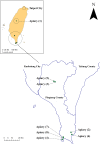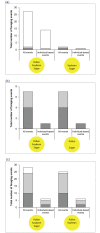Stop and Smell the Pollen: The Role of Olfaction and Vision of the Oriental Honey Buzzard in Identifying Food
- PMID: 26177533
- PMCID: PMC4503435
- DOI: 10.1371/journal.pone.0130191
Stop and Smell the Pollen: The Role of Olfaction and Vision of the Oriental Honey Buzzard in Identifying Food
Abstract
The importance of olfaction for various avian behaviors has become increasingly evident. So far, the use of olfaction for food detection among raptors has only been demonstrated for Cathartes vultures. The Oriental honey buzzard (Pernis orientalis) is a resident and migrant in Taiwan and regularly forages in apiaries. One of its foods in apiaries is yellow pollen dough, a softball-sized mixture of pollen, soybeans, and sugar that beekeepers provide as a supplementary food for bees. Given that pollen dough is not similar to any naturally occurring food, we hypothesized that buzzards identify the dough's nutritious contents using olfaction, perhaps in combination with vision. Using a series of choice experiments in which individuals could choose between two doughs, we showed that (1) buzzards almost unerringly chose pollen-containing over pollen lacking doughs when otherwise the doughs were identical in size, shape, and yellow color; (2) buzzards always preferred yellow over black or green doughs if both doughs contained pollen; (3) buzzards still preferred pollen-containing over pollen-lacking doughs when both doughs were black, but at a lower rate than in (1). We statistically excluded the possible influences of the doughs' relative brightness or of repeat visits by the same individuals. Our experiments thus suggest the use of a 'multi-modal foraging strategy' among buzzards whereby olfaction and vision are likely to be both used in identifying food at close distances. We also estimated the olfactory receptor gene repertoire size in the buzzard's genome which is almost five times as large as that of three other raptor species. Therefore, olfaction is likely of far greater ecological importance to this species than to other raptor species. We suggest that olfaction should be considered in the design of behavioral and genetic studies to better understand the use of multiple senses in avian behaviors.
Conflict of interest statement
Figures






Similar articles
-
Sight or smell: which senses do scavenging raptors use to find food?Anim Cogn. 2019 Jan;22(1):49-59. doi: 10.1007/s10071-018-1220-0. Epub 2018 Oct 26. Anim Cogn. 2019. PMID: 30367315 Free PMC article.
-
The Feather Structure of Oriental Honey Buzzards (Pernis ptilorhynchus) and Other Hawk Species in Relation to Their Foraging Behavior.Zoolog Sci. 2016 Jun;33(3):295-302. doi: 10.2108/zs150175. Zoolog Sci. 2016. PMID: 27268984
-
Seasonal contrasts in individual consistency of oriental honey buzzards' migration.Biol Lett. 2019 Jun 28;15(6):20190131. doi: 10.1098/rsbl.2019.0131. Epub 2019 Jun 12. Biol Lett. 2019. PMID: 31185821 Free PMC article.
-
The perfume of reproduction in birds: chemosignaling in avian social life.Horm Behav. 2015 Feb;68:25-42. doi: 10.1016/j.yhbeh.2014.06.001. Epub 2014 Jun 11. Horm Behav. 2015. PMID: 24928570 Free PMC article. Review.
-
Sensory ecology on the high seas: the odor world of the procellariiform seabirds.J Exp Biol. 2008 Jun;211(Pt 11):1706-13. doi: 10.1242/jeb.015412. J Exp Biol. 2008. PMID: 18490385 Review.
Cited by
-
Through an animal's eye: the implications of diverse sensory systems in scientific experimentation.Proc Biol Sci. 2024 Aug;291(2027):20240022. doi: 10.1098/rspb.2024.0022. Epub 2024 Jul 17. Proc Biol Sci. 2024. PMID: 39016597 Free PMC article. Review.
-
Sight or smell: which senses do scavenging raptors use to find food?Anim Cogn. 2019 Jan;22(1):49-59. doi: 10.1007/s10071-018-1220-0. Epub 2018 Oct 26. Anim Cogn. 2019. PMID: 30367315 Free PMC article.
-
Anatomical evidence for scent guided foraging in the turkey vulture.Sci Rep. 2017 Dec 12;7(1):17408. doi: 10.1038/s41598-017-17794-0. Sci Rep. 2017. PMID: 29234134 Free PMC article.
-
Insectivorous birds can see and smell systemically herbivore-induced pines.Ecol Evol. 2020 Aug 4;10(17):9358-9370. doi: 10.1002/ece3.6622. eCollection 2020 Sep. Ecol Evol. 2020. PMID: 32953066 Free PMC article.
-
Insectivorous birds eavesdrop on the pheromones of their prey.PLoS One. 2018 Feb 7;13(2):e0190415. doi: 10.1371/journal.pone.0190415. eCollection 2018. PLoS One. 2018. PMID: 29414994 Free PMC article.
References
-
- Cunningham SJ, Castro I, Potter MA. The relative importance of olfaction and remote touch in prey detection by North Island brown kiwis. Anim Behav. 2009;78(4): 899–905.
-
- Wenzel BM. Olfactory prowess of the kiwi. Nature. 1968;220: 1133–4. - PubMed
-
- Wallraff HG. Avian olfactory navigation: its empirical foundation and conceptual state. Anim Behav. 2004;67: 189–204.
-
- Trolle M, Walther BA. Preliminary bird observations in the rio Jauaperí region, rio Negro basin, Amazonia, Brazil. Cotinga. 2004;22: 81–5.
MeSH terms
LinkOut - more resources
Full Text Sources
Other Literature Sources

